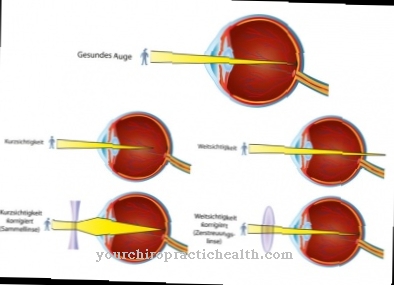A fibrous dysplasia Although it is a rare disease, it is the most common malformation of the bone system in children and adolescents. The prognosis and course of fibrous dysplasia that can be traced back to mutative changes are generally favorable.
What is fibrous dysplasia?

© Sebastian Kaulitzki - stock.adobe.com
Fibrous dysplasia is a rare benign disorder or lesion of the human skeleton that is associated with bone malformations and is attributed to mutative changes.
In this case, the synthesis of new bone mass is impaired (especially osteoblast differentiation), as a result of which fibrous connective tissue with immature non-lamellar trabeculae (non-fibrous trabeculae) is increasingly formed instead of healthy bone tissue. The dysregulated bone structure causes irregular bone growth with deformities that are characterized by structural instability and an increased risk of iterative (recurring) fractures and stress pain.
In general, the more common monostotic form, in which only one bone is affected, is differentiated from the polyostotic form of fibrous dysplasia involving several bones. The cranial and facial bones, thigh bones, tibia, humerus, ribs and hips are increasingly affected by fibrous dysplasia.
causes
Recent studies suggest a sporadic, postzygotic or metagamous mutation of the GNAS-1 gene on chromosome 20q13 as the cause of fibrous dysplasia.
The affected gene is responsible for the synthesis of certain units (alpha subunits) of the G proteins, which play an important role in the transmission of signals within the cell metabolism. As a result of the mutation, the enzyme adenylate cyclase is excessively activated and there is an overproduction of cell growth stimulating factors such as cAMP (cyclic adenosine monophosphate), which in turn control osteoblasts that regulate bone formation.
The resulting increased production of fibrous connective tissue leads to increased bone growth and bone deformation. Depending on where the mutation is located in the embryonic cell mass, fibrous dysplasia manifests itself later. In addition, it is assumed that postnatal mutations are responsible for monostotic and mutations in later embryonic development for the polyostotic variant of fibrous dysplasia, although the triggering factors for this are so far unknown.
Symptoms, ailments & signs
Fibrous dysplasia can take very different courses. The disease does not always cause noticeable symptoms or discomfort. Depending on the severity and which bones are affected, a number of signs can appear. Typical symptoms include slightly pulling bone pain that increases in intensity and duration with exercise. In addition, those affected have difficulty walking and, as a result, limp.
There is also an increased risk of so-called fatigue fractures. The sick suffer bone fractures and sprains even under light stress. Outwardly, fibrous dysplasia can be recognized by the visible bumps that result from the bone changes. Pigment disorders, so-called café-au-lait spots, can also occur.
They can be recognized by their light brown appearance and sharp edges. The spots represent a cosmetic flaw, but are otherwise harmless. They occur when the person has the inherited disease neurofibromatosis type 1 or McCune-Albright syndrome.
Children and adolescents who suffer from fibrous dysplasia grow faster than healthy people and reach puberty earlier. The disease often occurs together with other hormonal diseases, for example diabetes, Cushing's disease or a disorder of thyroid function.
Diagnosis & course
Fibrous dysplasia is diagnosed based on its characteristic symptoms. In addition to iterative bone fractures, these include hormonal disorders (including excess growth hormone), which accelerate the maturation process of the affected children and adolescents, possibly pigment disorders ("café-au-lait spots") or pronounced jawbone deformations (cherubism).
The frosted glass-like appearance of the affected bone areas, which is typical for fibrous dysplasia, can be made visible by radiography or computer tomography. In addition, active fibrous dysplasia often has an increased concentration of alkaline phosphatase in the serum and of hydroxyproline or deoxypyridinoline in the urine.
The diagnosis is confirmed by a biopsy of the affected bone with a subsequent microscopic examination. Other foci can be identified with a bone scintigram. Fibrous dysplasia usually has a favorable prognosis and the growth of the corresponding lesion usually comes to a standstill at the end of puberty. In rare cases (less than 1 percent), malignant changes (osteosarcoma) can be observed.
Complications
Fibrous dysplasia can cause serious complications if left untreated. First of all, there is an increased risk of breakage for the affected bone. The disease itself can be associated with functional disorders of the internal organs and thus lead to heart disease or thyroid malfunction. If the pancreas is affected, hormonal complaints, but also tumors, can occur.
In fibrous dysplasia, the skeletal muscles are more susceptible to so-called myxomas, benign tumors that restrict freedom of movement. In addition, the increased bone remodeling process can lead to an increase in alkaline phosphatase in the blood, which in the long term can lead to diseases of the skeletal muscles. In the further course of the disease, joint wear can occur.
Occasionally porous bones also develop, which in turn can be associated with serious complications. Surgical treatment of fibrous dysplasia also carries some risks. Internal injuries, infections and misalignments can occur during interventions on the axillary skeleton.
An operation on the skull bone can permanently impair its protective function. The bisphosphonates prescribed at the same time are associated with typical side effects such as nausea and vomiting, but can also cause severe bone necrosis and other complications.
When should you go to the doctor?
Since this disease does not usually heal itself, a doctor must be consulted. In this way, further complaints and complications can be avoided. The doctor should usually be seen if the person has irregular bone growth.
This can show through deformations in different parts of the body, although the skull is most affected by the symptoms. The disease also causes severe pain in the bones and can significantly limit the everyday life of the person affected. Particularly in children, there is very rapid growth and rapid maturation. If these symptoms also occur, a doctor must also be consulted. The risk of bone fractures is significantly increased by the disease, so that those affected suffer more often from injuries.
The diagnosis and treatment of this condition can usually be done either by a pediatrician or by a general practitioner. In some cases, surgical interventions are also necessary in order to completely limit the symptoms. This can make everyday life much easier for the person affected.
Doctors & therapists in your area
Treatment & Therapy
Since the exact etiology of fibrous dysplasia is not yet known, there is no causal therapy. Accordingly, the treatment measures aim to reduce the complaints and symptoms.
In many cases, fibrous dysplasia does not require any therapeutic measures and is only controlled clinically in its course. Medicines are used as part of symptomatic therapy to reduce pain. Although there are currently no active substances that completely stop the increased synthesis of fibrous connective tissue and the corresponding characteristic bone deformations, bisphosphonates (including risedronates, pamidronates, zoledronates) can slow the progression of fibrous dysplasia by inhibiting the so-called osteoclasts (cells that break down bone substance) and the stress pain is reduced.
If there is a progressive, pronounced deformation of the affected bones or corresponding clinical complaints, surgical intervention to avoid pathological fractures and malformations may be indicated. As part of a resection, the bone areas can be surgically removed, through which the mobility is restricted or supplying blood vessels and / or nerve tracts can be pinched.
In addition, a modeling operation for cosmetic reconstruction may be necessary, particularly in the face area. Radiotherapeutic measures, which are associated with an increased risk of sarcomas (malignant tumors), are now largely avoided in the treatment of fibrous dysplasia.
Outlook & forecast
If there is fibrous dysplasia, the exact outlook and prognosis are very difficult to predict. The explicit course of the disease depends on many different factors. The biggest factor in this is medical treatment. If such a treatment is used for fibrous dysplasia, rapid and uncomplicated healing can be expected.
If the sick person decides against medical and drug treatment, then the disease is very likely to get worse within a short time. The symptoms that occur are intensified, so that under certain circumstances a life-threatening situation can arise.
The entire course of the disease is different if the person concerned decides on medical and drug treatment. In such a case, the prospect and prognosis of a complete cure looks much better. The existing fever can be fought and relieved quickly with appropriate medication. Furthermore, further complications are prevented.
prevention
In view of the fact that the triggering factors for the underlying mutations are not yet known, fibrous dysplasia cannot be prevented. However, the course of the fibrous dysplasia should be checked regularly in order to detect malignant degeneration to an osteosarcoma at an early stage and to be able to treat accordingly.
Aftercare
As a rule, there are very few follow-up options available to those affected by this disease. The affected person is primarily dependent on the quick measures of an early diagnosis so that no further complications occur. Only with an early diagnosis can further complaints or a further worsening of the symptoms be prevented.
Self-healing cannot occur, so a visit to a doctor is definitely necessary for this disease. The earlier the doctor is consulted, the better the further course is usually also. The treatment of this disease is usually done by taking medication. It is important to ensure that it is taken regularly with the correct dosage.
In the case of children, parents in particular should ensure that they are taken correctly. However, surgical interventions are often necessary to alleviate the symptoms. After such an operation, the person concerned should definitely rest and take care of his body. Exertion or stressful activities should be avoided. No general predictions can be made about life expectancy in this disease.
You can do that yourself
The treatment of fibrous dysplasia can be supported by a few measures. If severe bone pain occurs, drug-based pain therapy can be promoted through rest and bed rest.
Since there is an increased risk of fractures with the disease, strenuous sports such as jogging, climbing or bodybuilding should not be performed.If a fracture does occur, a doctor must be consulted immediately. The doctor responsible should also be informed promptly of any incidents so that the therapy can be adjusted.
After an operation, rest is also indicated. The fibrous dysplasia itself cannot be cured by surgery, which is why medical check-ups must continue to be carried out. If the symptoms increase, countermeasures must be taken to compensate for the restricted mobility.
For example, many of those affected need a walking aid or a wheelchair, and facilities for the disabled are also required for seriously ill patients. Together with the doctor, these adjustments can be organized and implemented as the disease progresses. In this way, a high quality of life can be maintained even with relatively difficult processes.

.jpg)

.jpg)









.jpg)

.jpg)
.jpg)











.jpg)